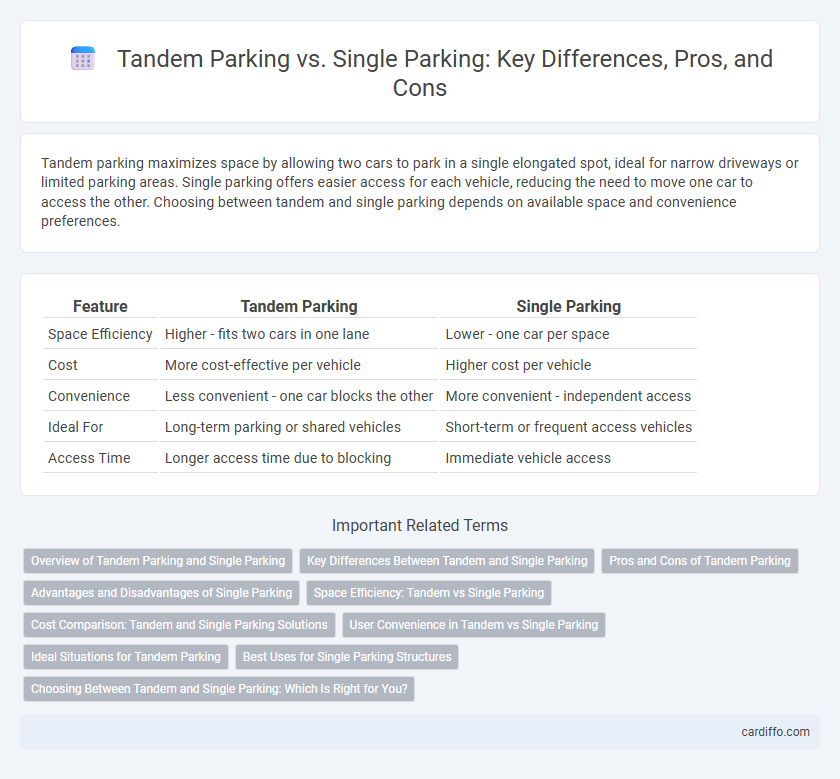Tandem parking maximizes space by allowing two cars to park in a single elongated spot, ideal for narrow driveways or limited parking areas. Single parking offers easier access for each vehicle, reducing the need to move one car to access the other. Choosing between tandem and single parking depends on available space and convenience preferences.
Table of Comparison
| Feature | Tandem Parking | Single Parking |
|---|---|---|
| Space Efficiency | Higher - fits two cars in one lane | Lower - one car per space |
| Cost | More cost-effective per vehicle | Higher cost per vehicle |
| Convenience | Less convenient - one car blocks the other | More convenient - independent access |
| Ideal For | Long-term parking or shared vehicles | Short-term or frequent access vehicles |
| Access Time | Longer access time due to blocking | Immediate vehicle access |
Overview of Tandem Parking and Single Parking
Tandem parking involves two vehicles parked one behind the other in a single elongated space, maximizing lot efficiency but requiring coordinated access. Single parking allocates individual spaces per vehicle, offering easier access and maneuverability without depending on the position of other cars. Choosing between tandem and single parking impacts space utilization, vehicle accessibility, and overall lot management.
Key Differences Between Tandem and Single Parking
Tandem parking requires two vehicles to park one behind the other in a single space, often maximizing limited driveway or garage space, whereas single parking allocates one vehicle per parking spot. Tandem parking can be less convenient due to the need to move the front vehicle to access the rear one, while single parking allows for independent entry and exit. Property layouts with space constraints typically favor tandem arrangements, whereas single parking suits locations prioritizing ease of access.
Pros and Cons of Tandem Parking
Tandem parking maximizes space efficiency by allowing two vehicles to share a single parking spot, ideal for narrow urban areas with limited room. However, it requires coordination between drivers since the vehicle parked in front blocks the one behind, potentially causing inconvenience during peak usage times. While cost-effective for property developers, tandem parking may reduce convenience and accessibility for users compared to single, independent parking spaces.
Advantages and Disadvantages of Single Parking
Single parking offers the advantage of easy access to each vehicle without needing to move another car, enhancing convenience and reducing time spent maneuvering. It typically allows for wider spaces, improving comfort and reducing the risk of door dings or scratches compared to tandem parking. However, single parking requires more space per vehicle, potentially limiting the total number of cars accommodated in a given area and increasing land usage costs.
Space Efficiency: Tandem vs Single Parking
Tandem parking maximizes space efficiency by allowing two vehicles to be parked in a single elongated spot, effectively doubling the capacity without increasing the footprint. Single parking spaces provide easier access and quicker entry or exit but require significantly more area for an equal number of vehicles. Urban environments benefit from tandem parking solutions when lot space is limited, although this can introduce coordination challenges for vehicle retrieval.
Cost Comparison: Tandem and Single Parking Solutions
Tandem parking offers a cost-efficient solution by maximizing space utilization, allowing two vehicles to share a single parking spot, which significantly reduces the overall cost per vehicle compared to single parking spaces. Single parking requires more space and higher construction expenses, leading to increased costs in urban environments where land is limited and expensive. Developers often prefer tandem parking in residential complexes to optimize land use while minimizing parking-related expenses and enhancing property value.
User Convenience in Tandem vs Single Parking
Tandem parking maximizes space efficiency by allowing two vehicles to park in a single elongated spot but can reduce user convenience due to the need for coordinated access between drivers. Single parking spaces offer direct access to each vehicle, simplifying entry and exit without dependency on the position of another car. Users valuing time-saving and independence generally prefer single parking despite its lower space efficiency compared to tandem arrangements.
Ideal Situations for Tandem Parking
Tandem parking is ideal for properties with limited space where maximizing vehicle capacity is essential, such as narrow urban lots or compact residential driveways. It works best when vehicles belong to the same household or frequent users who can coordinate car movements efficiently. This setup optimizes space usage without requiring additional access lanes, making it suitable for high-density living environments.
Best Uses for Single Parking Structures
Single parking structures offer optimal convenience and accessibility for users who need direct access to their vehicles without navigating multiple layers or sharing spaces. They are ideal for residential buildings or small commercial establishments where straightforward, individual vehicle access is essential. Single parking configurations enhance safety, reduce maneuvering time, and improve overall efficiency in areas with limited parking demand.
Choosing Between Tandem and Single Parking: Which Is Right for You?
Tandem parking maximizes space by allowing two vehicles to park in a single extended spot, ideal for properties with limited frontage or narrow driveways, whereas single parking offers direct access and greater convenience for everyday use. Choosing between tandem and single parking depends on factors such as vehicle access frequency, property layout, and the number of vehicles owned. For families with multiple cars and tight spaces, tandem parking is space-efficient, while single parking suits those prioritizing ease of entry and exit.
Tandem Parking vs Single Parking Infographic

 cardiffo.com
cardiffo.com